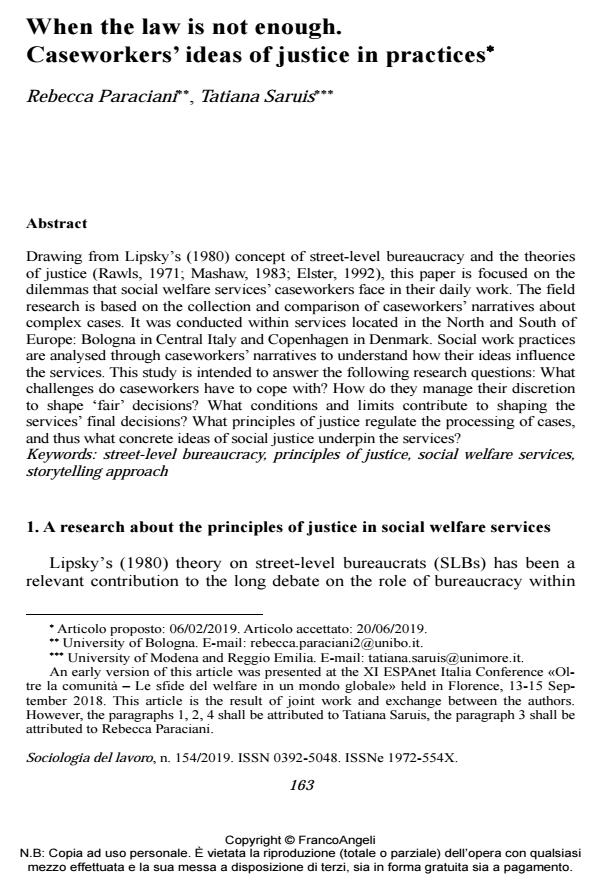When the law is not enough. Caseworkers’ ideas of justice in practices
Journal title SOCIOLOGIA DEL LAVORO
Author/s Rebecca Paraciani, Tatiana Saruis
Publishing Year 2019 Issue 2019/154
Language English Pages 20 P. 163-182 File size 215 KB
DOI 10.3280/SL2019-154009
DOI is like a bar code for intellectual property: to have more infomation
click here
Below, you can see the article first page
If you want to buy this article in PDF format, you can do it, following the instructions to buy download credits

FrancoAngeli is member of Publishers International Linking Association, Inc (PILA), a not-for-profit association which run the CrossRef service enabling links to and from online scholarly content.
Drawing from Lipsky’s (1980) concept of street-level bureaucracy and the theories of justice (Rawls, 1971; Mashaw, 1983; Elster, 1992), this paper is focused on the dilemmas that social welfare services’ caseworkers face in their daily work. The field research is based on the collection and comparison of caseworkers’ narratives about complex cases. It was conducted within services located in the North and South of Europe: Bologna in Central Italy and Copenhagen in Denmark. Social work practices are analysed through caseworkers’ narratives to understand how their ideas influence the services. This study is intended to answer the following research questions: What challenges do caseworkers have to cope with? How do they manage their discretion to shape ‘fair’ decisions? What conditions and limits contribute to shaping the services’ final decisions? What principles of justice regulate the processing of cases, and thus what concrete ideas of social justice underpin the services?
Keywords: Street-level bureaucracy, principles of justice, social welfare services, storytelling approach
- Labour Inspectors in Italy Rebecca Paraciani, pp.9 (ISBN:978-3-031-37996-3)
- Labour Inspectors in Italy Rebecca Paraciani, pp.43 (ISBN:978-3-031-37996-3)
- Organising Changes: The Institutional Work Behind the Implementation of a Minimum Income Scheme Tommaso Frangioni, Stella Volturo, in Social Policy & Administration spol.70026/2025
DOI: 10.1111/spol.70026 - Who is the (“Ideal”) Victim of Labor Exploitation? Two Qualitative Vignette Studies on Labor Inspectors’ Discretion Kim Loyens, Rebecca Paraciani, in The Sociological Quarterly /2023 pp.27
DOI: 10.1080/00380253.2021.1974321
Rebecca Paraciani, Tatiana Saruis, When the law is not enough. Caseworkers’ ideas of justice in practices in "SOCIOLOGIA DEL LAVORO " 154/2019, pp 163-182, DOI: 10.3280/SL2019-154009